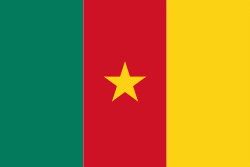Mbalmayo
Mbalmayo is a town in Cameroon's Centre Region. The town had 60,091 inhabitants in 2012. It is the capital of the Nyong-et-So'o Division It is located at the banks of the Nyong river between Ebolowa and Yaoundé. It is an agricultural centre and has an important function as a centre of education. It has several primary and secondary schools owned by the government, Roman Catholic Church, Religious bodies and lay Private individuals. It is a beautiful town with many tourist attractions, once in town you can visit the Roman Catholic cathedral built during the colonial era, the water catchment at Akomnyada, the Marianne Sanctuary at Nkolbindi, two wood transformation factories Exam placage and COCAM, an old German bridge across the Nyong river constructed by Germans in the early 1900s and so on. The hotel and lodging sector is fast growing with many modern hotels and lodging structures springing up like mushrooms.
Site of the Mbalmayo National Forestry School.
Mbalmayo had existed since 1910 during the German rule of the then Kamerun. Mbalmayo was founded by Mbala Meyo, one of the first ruler of the town. As was the custom of chiefs who rule large communities prior to colonialism, villages and town were named after the chief. This trend of events could be seen in the other neighboring town and villages such as Akonolinga, Nanga Ebogo and Abong Bang, just to name a few.
The Germans had administrative control over the town and made use of the Nyong river for transportation of timber which was a major source of income. Due to its economic potentials, the Germans before the First World War had intended to establish an administrative headquarters in Mbalmayo. Also partly because they found a rock in the Nyong river with a protruded rounded wait which was attractive especially for touristic activities. However, immediately after the first world war in 1919, when Germany had to cede power to the Allied Forces, the project was never realized. The Town was handed to the French as French protectorate by the United Nations.
Site of the Mbalmayo National Forestry School.
Mbalmayo had existed since 1910 during the German rule of the then Kamerun. Mbalmayo was founded by Mbala Meyo, one of the first ruler of the town. As was the custom of chiefs who rule large communities prior to colonialism, villages and town were named after the chief. This trend of events could be seen in the other neighboring town and villages such as Akonolinga, Nanga Ebogo and Abong Bang, just to name a few.
The Germans had administrative control over the town and made use of the Nyong river for transportation of timber which was a major source of income. Due to its economic potentials, the Germans before the First World War had intended to establish an administrative headquarters in Mbalmayo. Also partly because they found a rock in the Nyong river with a protruded rounded wait which was attractive especially for touristic activities. However, immediately after the first world war in 1919, when Germany had to cede power to the Allied Forces, the project was never realized. The Town was handed to the French as French protectorate by the United Nations.
Map - Mbalmayo
Map
Country - Cameroon
 |
 |
| Flag of Cameroon | |
Early inhabitants of the territory included the Sao civilisation around Lake Chad, and the Baka hunter-gatherers in the southeastern rainforest. Portuguese explorers reached the coast in the 15th century and named the area Rio dos Camarões (Shrimp River), which became Cameroon in English. Fulani soldiers founded the Adamawa Emirate in the north in the 19th century, and various ethnic groups of the west and northwest established powerful chiefdoms and fondoms. Cameroon became a German colony in 1884 known as Kamerun. After World War I, it was divided between France and the United Kingdom as League of Nations mandates. The Union des Populations du Cameroun (UPC) political party advocated independence, but was outlawed by France in the 1950s, leading to the national liberation insurgency fought between French and UPC militant forces until early 1971. In 1960, the French-administered part of Cameroon became independent, as the Republic of Cameroun, under President Ahmadou Ahidjo. The southern part of British Cameroons federated with it in 1961 to form the Federal Republic of Cameroon. The federation was abandoned in 1972. The country was renamed the United Republic of Cameroon in 1972 and back to the Republic of Cameroon in 1984 by a presidential decree by president Paul Biya. Paul Biya, the incumbent president, has led the country since 1982 following Ahidjo's resignation; he previously held office as prime minister from 1975 on. Cameroon is governed as a Unitary Presidential Republic.
Currency / Language
| ISO | Currency | Symbol | Significant figures |
|---|---|---|---|
| XAF | Central African CFA franc | Fr | 0 |
| ISO | Language |
|---|---|
| EN | English language |
| FR | French language |















